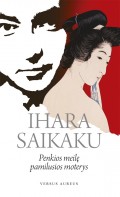 Original language:
japanese
Original language:
japanese Translated from: English
Authors: Ihara Saikaku
Translated by: Jomantienė, Irena, Dyke, Milda
ISBN: 978-9955-34-235-9
Published in: Vilnius
Published on: 2009
Publisher: Versus Aureus
Five women, five love stories. “Five Women Who Loved Love” is a book which follows five determined women lives who were so bold as to seek love and pleasure, in spite of social attitudes about such things. The five heroines are Onatsu, already wise in the ways of love by the age of sixteen; Osen, a faithful wife until unjustly accused of adultery; Osan, a Kyoto beauty who falls asleep in the wrong bed; Oshichi, willing to burn down a city to meet her samurai lover; and Oman, who has to compete with handsome boys to win her lover\’s affections. The heroines are not always admirable women, and their loves are not always beautiful, some of them are little more than aggressive pleasure seekers…
Still the book is more than a collection of skillfully told erotic tales, it is more about lovers who experience great depth of emotion and caring. The women in this book are from the newly coalescing middle class. This class itself has an outlaw spirit when contrasted to the feudal mentality in which birth and rank dictate everything. In this time our heroines and they lovers are often torn between the love they feel for one another, and the duty that conspires to keep them apart. The force of their individuality, which encompasses their choices in sexuality and love, leads to disaster in all but one of the stories.
“Five Women Who Loved Love” (1686) was an immediate bestseller in the bawdy, life-loving world that was Edo Japan.
Ihara Saikaku (1642 – 1693) was a Japanese poet and novelist, one of the most brilliant figures of the 17th-century. He was a man of many talents. Not only did he have a penchant for poetry, but he had a gift for writing edgy plays and novels with a radical flair. He first won fame for his speed in composing haikai (humorous linked-verse poems), once producing 23,500 in a day. He is best known for his novels: his first novel “The Life of an Amorous Man” (1682), which depicted the life of the merchant class; “The Life of an Amorous Woman” (1686); the collection of novellas “Five Women Who Loved Love” (1686), “The Encyclopedia of Male Love” (1687) .
Ihara Saikaku was the first Japanese writer to reflect the life of the modern city and to support the third estate in its demand for equality. He influenced the development of the national literature not only by the new content of his works but also by his style. Today he even is called the Japanese Boccaccio.
